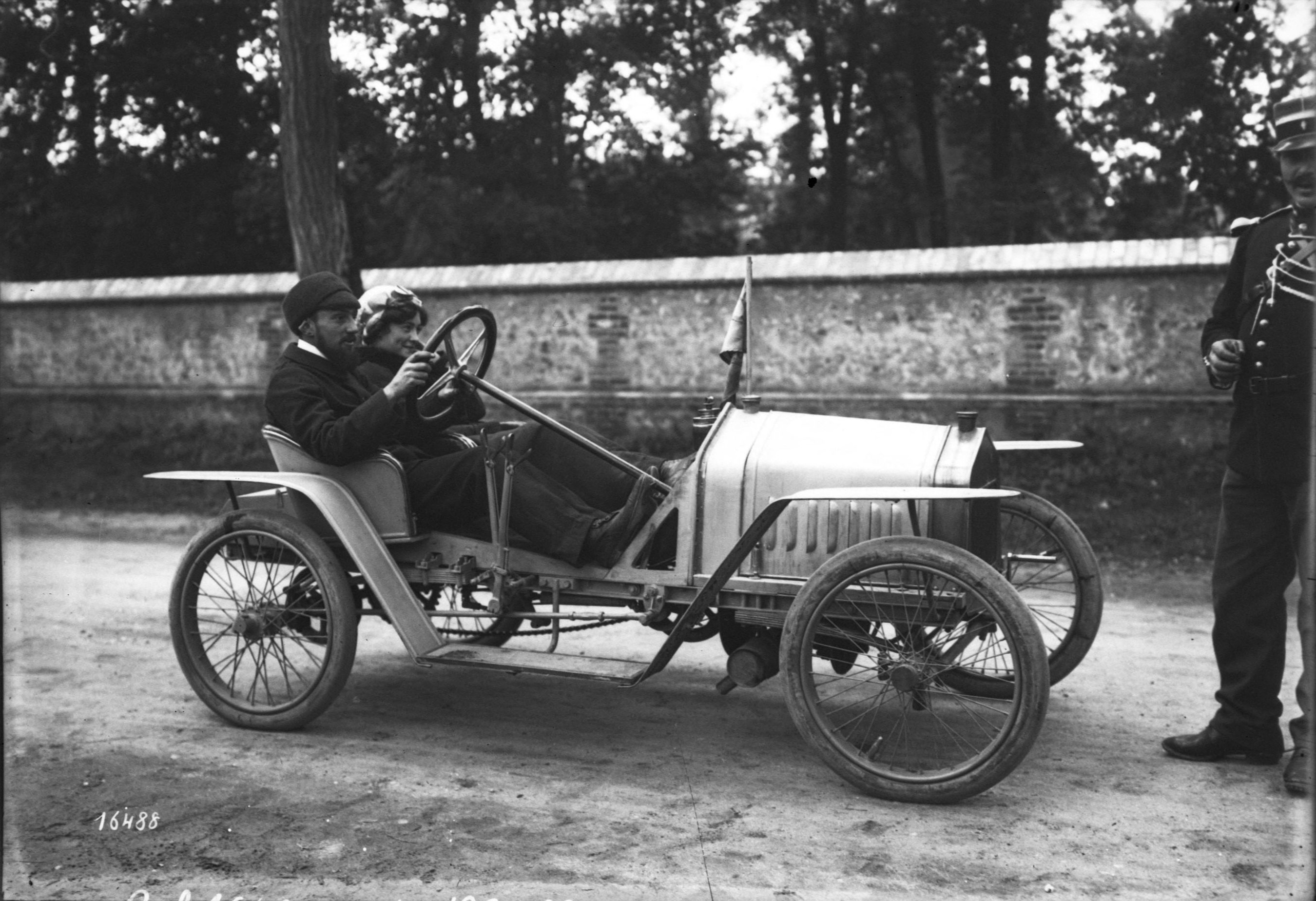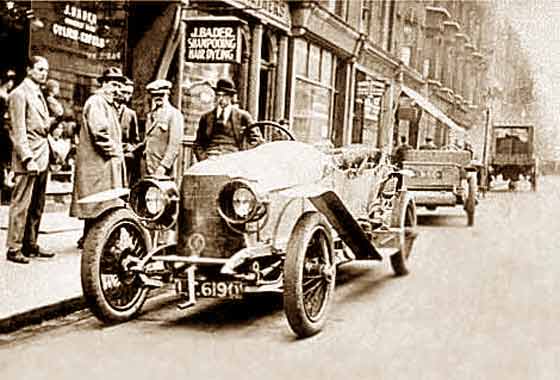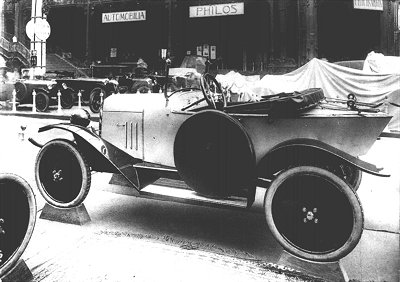|
Cyclecar
A cyclecar was a type of small, lightweight and inexpensive motorized car manufactured in Europe and the United States between 1910 and the early 1920s. The purpose of cyclecars was to fill a gap in the market between the motorcycle and the car. It could accommodate only two passengers, often sitting in tandem. The demise of cyclecars was due to larger cars – such as the Citroën Type C, Austin 7 and Morris Cowley – becoming more affordable. Small, inexpensive vehicles reappeared after World War II, and were known as microcars. Characteristics Cyclecars were propelled by engines with a single cylinder or V-twin configuration (or occasionally a three or four cylinder engine), which were often air-cooled. Sometimes motorcycle engines were used, in which case the motorcycle gearbox was also used. All cyclecars were required to have clutches and variable gears. This requirement could be fulfilled by even the simplest devices such as provision for slipping ... [...More Info...] [...Related Items...] OR: [Wikipedia] [Google] [Baidu] |
Bédélia
Bédélia from 1910 in 1975 at the Nürburgring Bédélia (in English usually written as ''Bedelia'') was the archetype of the French cyclecars. This automobile was manufactured by the Bourbeau et Devaux Co. of Paris from 1910 to 1925 to a design by Robert Bourbeau. Rather than scaling down existing motor-car designs, Bourbeau chose to adapt mainly motor-cycle practice for his design, giving rise to the cyclecar designation. The low and light car carried its two passengers in tandem with the passenger seated at the front, while in the rear was the person doing the steering. Single-cylinder or 10 hp V-twin engines were used. Drive was to the rear wheels through a belt which could be moved between pulleys to give a two speed transmission. The front axle was centre pivoted with suspension by a single mid mounted coil spring and the steering was by a cable and bobbin. Elliptic leaf springs were used at the rear. The method of changing gear was unusual. The rear driver had to o ... [...More Info...] [...Related Items...] OR: [Wikipedia] [Google] [Baidu] |
GN (car)
The GN was a British cyclecar made in London, between 1910 and 1925. The name derived from its founders, H.R. Godfrey and Archibald Frazer-Nash. Production ceased in 1923 but the company kept trading until 1925. History The GN cyclecar was made in Hendon, North London, between 1910 and 1925, then moving to Wandsworth, London. The name derives from its founders, Henry Ronald Godfrey, H.R. Godfrey (1887-1968) and Archibald Frazer-Nash (1889-1965). Production ceased in 1923 but the company kept trading until 1925. After making several cars for their own use, the two founders launched the GN car in 1909, building them in the stables at the Frazer Nash family home. The car was powered by a V twin engine by JA Prestwich Industries Ltd, JAP or Peugeot with belt drive to the rear wheels. By 1911, production had moved to Hendon and GN's own 1100 cc engine, using some Peugeot parts being fitted. The engine was mounted in the chassis with the crankshaft parallel to the front axle, ... [...More Info...] [...Related Items...] OR: [Wikipedia] [Google] [Baidu] |
V-twin Engine
A V-twin engine, also called a V2 engine, is a two-cylinder piston engine where the cylinders are arranged in a V configuration and share a common crankshaft. The V-twin is widely associated with motorcycles, primarily installed longitudinally, though also transversely. They are also used in a variety of other land, air, and marine vehicles, as well as industrial applications. The V-twin design dates back to the late 1880s. Origins One of the first V-twin engines was built by Gottlieb Daimler in 1889. It was used as a stationary engine, for boats and in the Daimler Stahlradwagen ("steel-wheeled car"), Daimler's second car. The engine was also manufactured under licence in France by Panhard et Levassor. An early V-twin engined motorcycle was produced in November 1902 by the Princeps AutoCar Company in the United Kingdom. The following year, V-twin motorcycles were produced by Eclipse Motor & Cycle Co in the United Kingdom (the ''XL-ALL'' model), Glenn Curtiss in the United ... [...More Info...] [...Related Items...] OR: [Wikipedia] [Google] [Baidu] |
JPL (cyclecar)
The JPL was a brass era cyclecar built in Detroit, Michigan by the J.P.L. Cyclecar Company, formed in 1913. Production started in December 1913 but ended in 1914. History The JPL was designed by J.P. La Vigne who was an early and ubiquitous engineer in the industry. The car was marketed both as the JPL and the La Vigne. The cyclecar was equipped with a engine with a transmission. A bore and stroke of made for a displacement of and a claimed maximum power of . The underslung design made for a particularly low profile. The vehicle was claimed to get and have a top speed of . The original model was available either as a roadster, a cabriolet A convertible or cabriolet () is a passenger car that can be driven with or without a roof in place. The methods of retracting and storing the roof vary across eras and manufacturers. A convertible car's design allows an open-air driving ex ..., or a delivery wagon. A revised design, the Model F, was shown in mid-1914 with a pr ... [...More Info...] [...Related Items...] OR: [Wikipedia] [Google] [Baidu] |
Morgan Motor Company
Morgan Motor Company Limited is a British automobile, motor car manufacturer owned by a British investment group Investindustrial. Morgan was founded in 1910 by H. F. S. Morgan, Henry Frederick Stanley Morgan. Morgan is itself based in Malvern Link, an area of Malvern, Worcestershire, Malvern, and employs approximately 220 people. Morgan produce 850 cars per year, all assembled by hand. The waiting list for a car is approximately six months, but it has sometimes been as long as ten years. Morgan cars are unusual in that wood has been used in their construction for a century, and is still used in the 21st century for framing the body shell. A visitor centre and museum have exhibits about the company's history from Edwardian times until the present day, developments in automobile technology, and a display of automobiles. There are also guided tours of the factory. Company history H.F.S. Morgan quit the Great Western Railway in 1904 and co-founded a motor sales and servicing gar ... [...More Info...] [...Related Items...] OR: [Wikipedia] [Google] [Baidu] |
British Automobile Racing Club
The British Automobile Racing Club (BARC) is one of the biggest organising clubs for auto racing, motor racing in the United Kingdom. History The Cyclecar Club was formed in 1912, running races for the small and light Motorcycle, motorbike powered vehicles at Brooklands as well as Rallying, rallies and sporting trials. Among the founder members of the club were Henry Ronald Godfrey, H.R. Godfrey and Archibald Frazer-Nash, Archie Frazer-Nash. In 1919, with cyclecars on the decline, the name of the club changed to the Junior Car Club (JCC). The club was immediately successful, with regional centres being formed in 1921, the same year the 200-Mile Race at Brooklands was organised, the first long-distance race to be run in United Kingdom of Great Britain and Ireland, Britain. The race, a contest for 1,500 c.c. light cars, was won by Henry Segrave in a Talbot-Darracq. Captain Frazer Nash (GN (car), G.N.) won the cyclecar race. Further long-distance races were organised both at Brook ... [...More Info...] [...Related Items...] OR: [Wikipedia] [Google] [Baidu] |
Austro (automobile) , ed., The Complete Encyclopedia of Motorcars 1885-1968 (New York: E.P. Dutton and Co., 1974).
The Austro was an Austrian automobile manufactured from 1913 to 1914. It was one of few cyclecars produced in Central Europe. Powered by a 6 horsepower NSU engine, it had a 4-speed gearbox and double chain final drive. It had an independent front suspension, using sliding pillars on the lines of the Morgan. Austro cyclecars did well in mountain trials, as well as the Semmering Hill Climbs. Austro also manufactured aeroplanes. References * "Austro", in G.N. Georgano George Nicolas "Nick" Georgano (29 February 1932 – 22 October 2017Nick Georgano Alvis Archive Bl ... Classic, Vintage and Veteran ... [...More Info...] [...Related Items...] OR: [Wikipedia] [Google] [Baidu] |
Austin 7
The Austin 7 is an economy car that was produced from 1922 until 1939 in the United Kingdom by Austin. It was nicknamed the "Baby Austin" and was at that time one of the most popular cars produced for the British market and sold well abroad. Its effect on the British market was similar to that of the Model T Ford in the US, replacing most other British economy cars and cyclecars of the early 1920s. It was also licensed and copied by companies all over the world. The first BMW car, the BMW Dixi, was a licensed Austin 7. In France they were made and sold as Rosengarts, and in the United States they were built by the American Austin Car Company. In Japan, Nissan also used the 7 design as the basis for their first cars, although not under licence. This eventually led to a 1952 agreement for Nissan to build and sell Austins (which were now being made under the British Motor Corporation) in Japan under the Austin name. Many Austin 7s were rebuilt as "specials" after the S ... [...More Info...] [...Related Items...] OR: [Wikipedia] [Google] [Baidu] |
Citroën Type C 5HP
The Citroën Type C was a light car made by the French Citroën car company between 1922 and 1926 with almost 81,000 units being made. Known as Citroën Tax horsepower, 5HP or 5CV in France and 7.5HP in Britain, it was the second model of automobile designed and marketed by André Citroën, between 1922 and 1926. It followed the 10HP "Type A " (1919), then 10HP "B2" (1921); they were the first European mass-produced cars. The first colour in which it was made was a pale "grapefruit" yellow which earned it the first nickname "petite citron" (little lemon). It was also nicknamed "Cul de poule" (hen's bottom) or "boat tail" due to the rear of the little car's body and also "Trefle" (clover leaf) referring to the shape of the three-seat version. History Sources The genesis of the Type C took place in the immediate post-war period, when the whole of Europe was in a disastrous state, especially economically, with relentless inflation reducing the value of savings and investme ... [...More Info...] [...Related Items...] OR: [Wikipedia] [Google] [Baidu] |
Bubble Car
Microcar is a term often used for the smallest size of cars, with three or four wheels and often an engine smaller than . Specific types of microcars include bubble cars, cycle cars, invacar, quadricycles and voiturettes. Microcars are often covered by separate regulations to normal cars, having relaxed requirements for registration and licensing. Predecessors Voiturette is a term used by some small cars and tricycles manufactured from 1895 to 1910. Cyclecars are a type of small, lightweight and inexpensive car manufactured mainly between 1910 and the late 1920s. Europe 1940–1970: Microcars The first cars to be described as microcars (earlier equivalents were called voiturettes or cyclecars) were built in the United Kingdom and Germany following World War II, and remained popular until the 1960s. They were originally called minicars, but later became known as microcars. France also produced large numbers of similar tiny vehicles called voiturettes, but they were r ... [...More Info...] [...Related Items...] OR: [Wikipedia] [Google] [Baidu] |
Microcars
Microcar is a term often used for the smallest size of cars, with three or four wheels and often an engine smaller than . Specific types of microcars include #Bubble cars, bubble cars, cycle cars, invacar, quadricycle (EU vehicle classification), quadricycles and voiturettes. Microcars are often covered by separate regulations to normal cars, having relaxed requirements for registration and licensing. Predecessors Voiturette is a term used by some small cars and tricycles manufactured from 1895 to 1910. Cyclecars are a type of small, lightweight and inexpensive car manufactured mainly between 1910 and the late 1920s. Europe 1940–1970: Microcars The first cars to be described as microcars (earlier equivalents were called voiturettes or cyclecars) were built in the United Kingdom and Germany following World War II, and remained popular until the 1960s. They were originally called minicars, but later became known as microcars. France also produced large numbers of similar ... [...More Info...] [...Related Items...] OR: [Wikipedia] [Google] [Baidu] |








